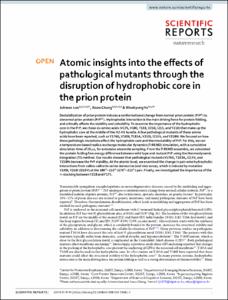Department of Brain Sciences
Theoretical and Computational Biophysics Laboratory
1. Journal Articles
Full metadata record
| DC Field | Value | Language |
|---|---|---|
| dc.contributor.author | Lee, Ju Hwan | ko |
| dc.contributor.author | Chang, Iksoo | ko |
| dc.contributor.author | Yu, Wookyung | ko |
| dc.date.accessioned | 2020-02-27T08:41:00Z | - |
| dc.date.available | 2020-02-27T08:41:00Z | - |
| dc.date.created | 2019-12-27 | - |
| dc.date.issued | 2019-12 | - |
| dc.identifier.citation | Scientific Reports, v.9, no.1 | - |
| dc.identifier.issn | 2045-2322 | - |
| dc.identifier.uri | http://hdl.handle.net/20.500.11750/11380 | - |
| dc.description.abstract | Destabilization of prion protein induces a conformational change from normal prion protein (PrPC) to abnormal prion protein (PrPSC). Hydrophobic interaction is the main driving force for protein folding, and critically affects the stability and solvability. To examine the importance of the hydrophobic core in the PrP, we chose six amino acids (V176, V180, T183, V210, I215, and Y218) that make up the hydrophobic core at the middle of the H2-H3 bundle. A few pathological mutants of these amino acids have been reported, such as V176G, V180I, T183A, V210I, I215V, and Y218N. We focused on how these pathologic mutations affect the hydrophobic core and thermostability of PrP. For this, we ran a temperature-based replica-exchange molecular dynamics (T-REMD) simulation, with a cumulative simulation time of 28 μs, for extensive ensemble sampling. From the T-REMD ensemble, we calculated the protein folding free energy difference between wild-type and mutant PrP using the thermodynamic integration (TI) method. Our results showed that pathological mutants V176G, T183A, I215V, and Y218N decrease the PrP stability. At the atomic level, we examined the change in pair-wise hydrophobic interactions from valine-valine to valine-isoleucine (and vice versa), which is induced by mutation V180I, V210I (I215V) at the 180th–210th (176th–215th) pair. Finally, we investigated the importance of the π-stacking between Y218 and F175. © 2019, The Author(s). | - |
| dc.language | English | - |
| dc.publisher | Nature Research | - |
| dc.title | Atomic insights into the effects of pathological mutants through the disruption of hydrophobic core in the prion protein | - |
| dc.type | Article | - |
| dc.identifier.doi | 10.1038/s41598-019-55661-2 | - |
| dc.identifier.wosid | 000503178500001 | - |
| dc.identifier.scopusid | 2-s2.0-85076612561 | - |
| dc.type.local | Article(Overseas) | - |
| dc.type.rims | ART | - |
| dc.description.journalClass | 1 | - |
| dc.identifier.citationVolume | 9 | - |
| dc.identifier.citationNumber | 1 | - |
| dc.identifier.citationTitle | Scientific Reports | - |
| dc.type.journalArticle | Article | - |
| dc.description.isOpenAccess | Y | - |
| dc.subject.keywordPlus | STRAUSSLER-SCHEINKER DISEASE | - |
| dc.subject.keywordPlus | STABILITY CHANGES | - |
| dc.subject.keywordPlus | NMR STRUCTURE | - |
| dc.subject.keywordPlus | PATHOGENIC MUTATIONS | - |
| dc.subject.keywordPlus | MOLECULAR-DYNAMICS | - |
| dc.subject.keywordPlus | CREUTZFELDT-JAKOB | - |
| dc.subject.keywordPlus | GLYCOSYLATION | - |
| dc.subject.keywordPlus | PREDICTION | - |
| dc.subject.keywordPlus | SIMULATIONS | - |
| dc.subject.keywordPlus | SERVER | - |
| dc.contributor.affiliatedAuthor | Chang, Iksoo | - |
| dc.contributor.affiliatedAuthor | Yu, Wookyung | - |
- Files in This Item:
-
 기타 데이터 / 6.86 MB / Adobe PDF
download
기타 데이터 / 6.86 MB / Adobe PDF
download



